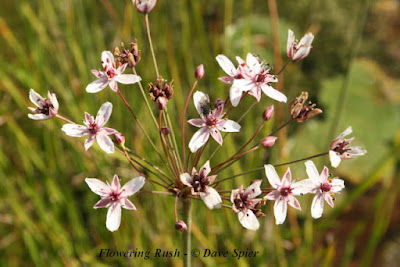 |
| Bur-marigolds at the Montezuma Audubon Center, Savannah, NY, in September |
Check your local damp meadows and marsh edges for a golden haze of beautiful, yellow, native wildflowers called bur-marigolds (Bidens species). Resembling small sunflowers, the bright-yellow flowers have an average of eight rays around a central disk. Not surprisingly both the sunflower and bur-marigold are in the Aster (or Composite) family.
Two species may occur in New York. The Showy, or Larger, Bur-marigold (B. laevis) has rays longer than a half inch and flower heads up to two inches in diameter. This species is found mainly from California across the lower (southern) states, and locally into the Midwest and also New York along the Lake Ontario plain. Apparently it's also widespread along the East Coast to Massachusetts. A second species, Nodding Bur-marigold (Bidens cernua) has smaller yellow flowers that nod as they ripen. It is widespread across Canada and the continental states except the Southeast and it's the more-likely species in New York, especially the Finger Lakes Region. Both species have opposite leaves that are narrow, long-pointed and toothed along the margins. The leaves of B. cernua are sessile (stalkless) and hug the often-rough stems. B. laevis is smooth-stemmed with leaves that narrow (taper) at the base. The Finger Lakes Native Plant Society has an excellent species profile on their website.
Bur-marigolds also are known as beggar-ticks and stick-tights, referring to the sharply three-pronged seeds [achenes] that stick to clothes as you brush by a ripe plant. The numerous seeds are eaten by upland and aquatic birds.
Additional reference:
Newcomb's Wildflower Guide, by Lawrence Newcomb and Gordon Morrison (© 1977), published by Little, Brown & Co.
Corrections, comments and questions are always welcome at northeastnaturalist@yahoo.com or you can connect through my Facebook page at Dave Spier (photographic naturalist) or my personal page, Dave Spier with the profile photo of me birding through a spotting scope. There's a new Fb page for The Northeast Naturalist.










